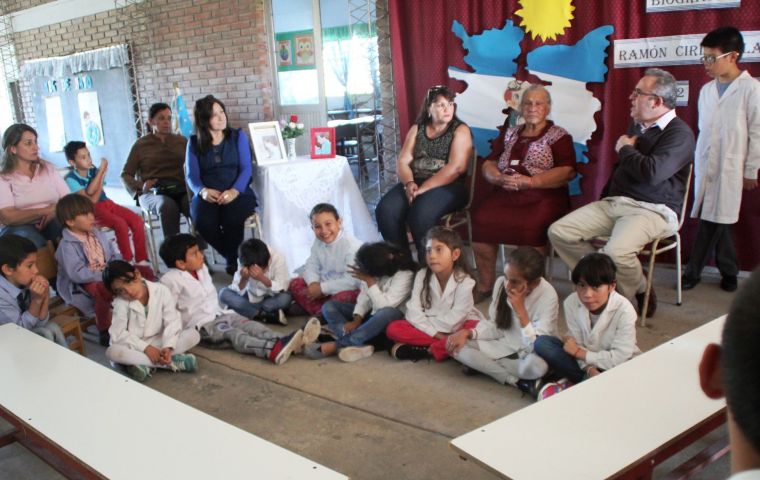MercoPress. South Atlantic News Agency
Students from a rural school helped identify an Argentine combatant buried in the Falklands
 Monica Gomez (right), aunt of Ramon and who raised him, next to researcher Florencia Conde and the children from a rural school in the province of Corrientes
Monica Gomez (right), aunt of Ramon and who raised him, next to researcher Florencia Conde and the children from a rural school in the province of Corrientes A project led by students at a rural school in San Luis de Palmar, the Argentine province of Corrientes, helped identify the remains of a fallen combatant during the South Atlantic conflict: Ramón Cirilo Blanco, according to researchers at the Universidad Nacional del Nordeste (UNNE).
Students at Rural School N°784 worked with UNNE investigators in 2018 to establish the life story of Blanco, whose unidentified remains had been buried in the Argentine military cemetery at Darwin in the Falkland Islands, the control of which Argentina sought during its failed invasion of the British Overseas Territory in 1982.
Little was known about Blanco prior to the investigation, UNNE researcher Florencia Conde told the Buenos Aires newspaper Perfil in an interview. The project came about after the school's principal decided the institution should be renamed.
“One of the options discussed was to name it after the man who donated the land where the school is located and the other came about after someone mentioned it was also located in 'an area where a Malvinas soldier lived but never returned'”, she added.
“We knew nothing about the life of Ramón because he came from an unusual family background: he was raised in three places with different aunts and grandmothers because his mother had to leave for work, and couldn't take him”, Conde said.
“We had to reconstruct his life story in different places”.
Conde said the students took on the role of private investigators, interviewing people who may have known the fallen soldier.
They eventually found Mónica Gómez, Blanco's sister on his mother's side. ”When we visited her, she said she hoped to one day complete DNA testing (to help identify her brother), but didn't know how or where to go”, the researcher added.
It was not easy talking to her since Monica spoke mostly Guarani, the prevailing language among the indigenous people of north Argentina.
Soon after, Gómez was contacted by the organization No Me Olvides (Don't Forget Me) who supported her in the process of DNA testing.
Her DNA helped identify her brother's grave in early 2019 during the humanitarian mission to the Falklands/Malvinas led by the International Red Cross, following on an agreement between Argentina and UK, plus Falklands' consent, and supported by Argentina's Forensic Anthropology Unit.




Top Comments
Disclaimer & comment rules-

Read all comments“ Helped identify ” Bollocks, load of codswallop.The pupils used DNA did they?
Jun 14th, 2019 - 03:56 pm 0Commenting for this story is now closed.
If you have a Facebook account, become a fan and comment on our Facebook Page!